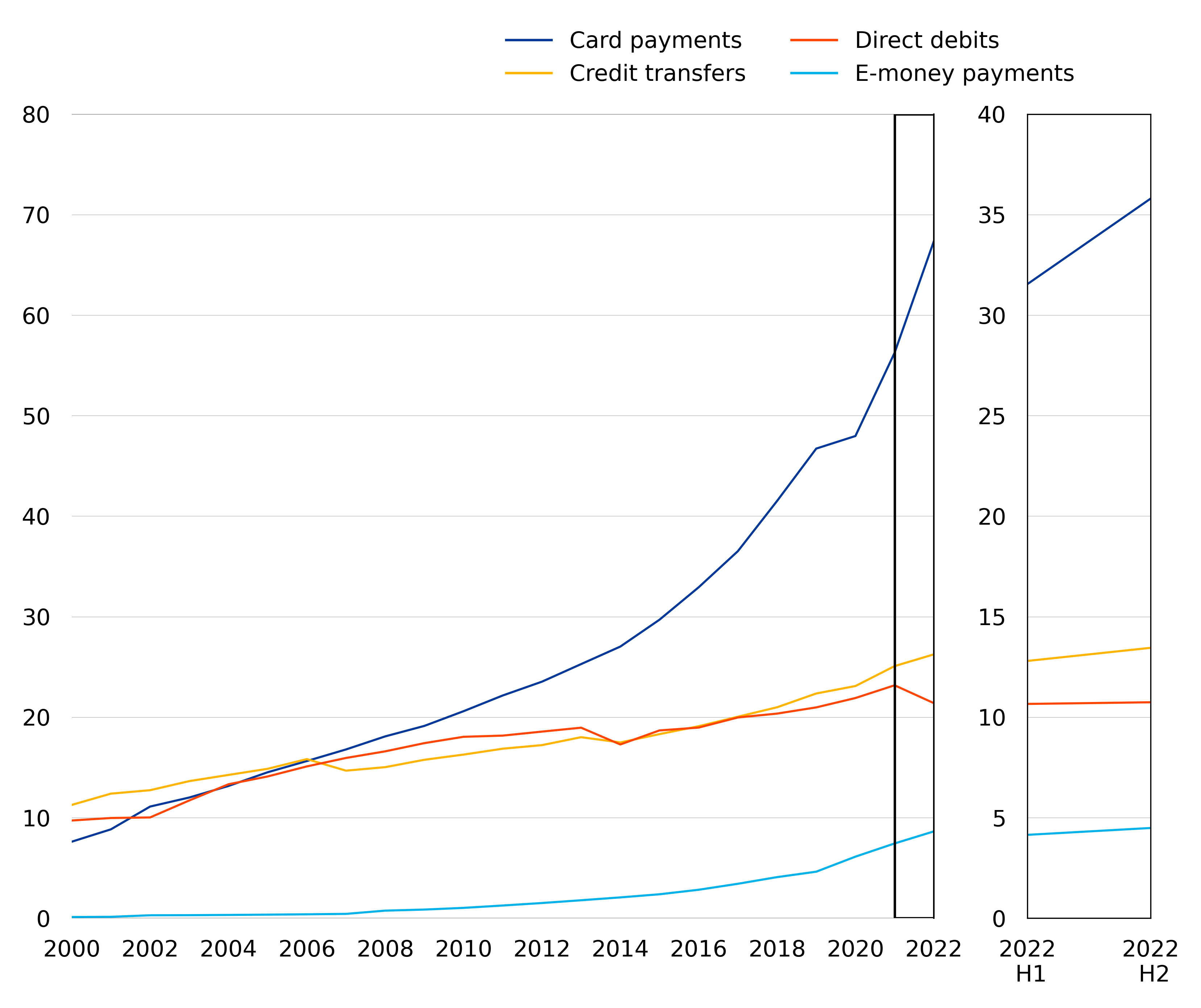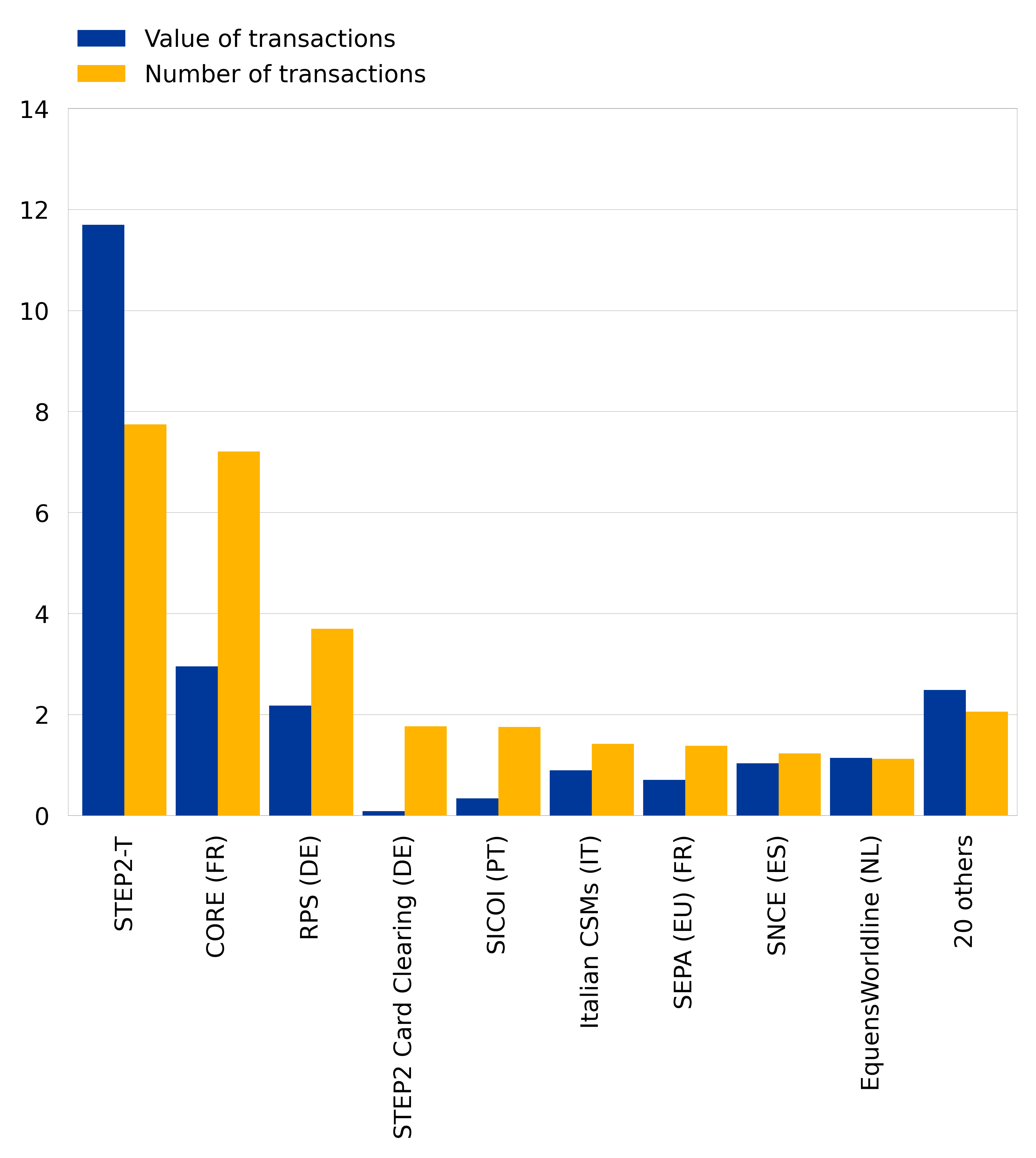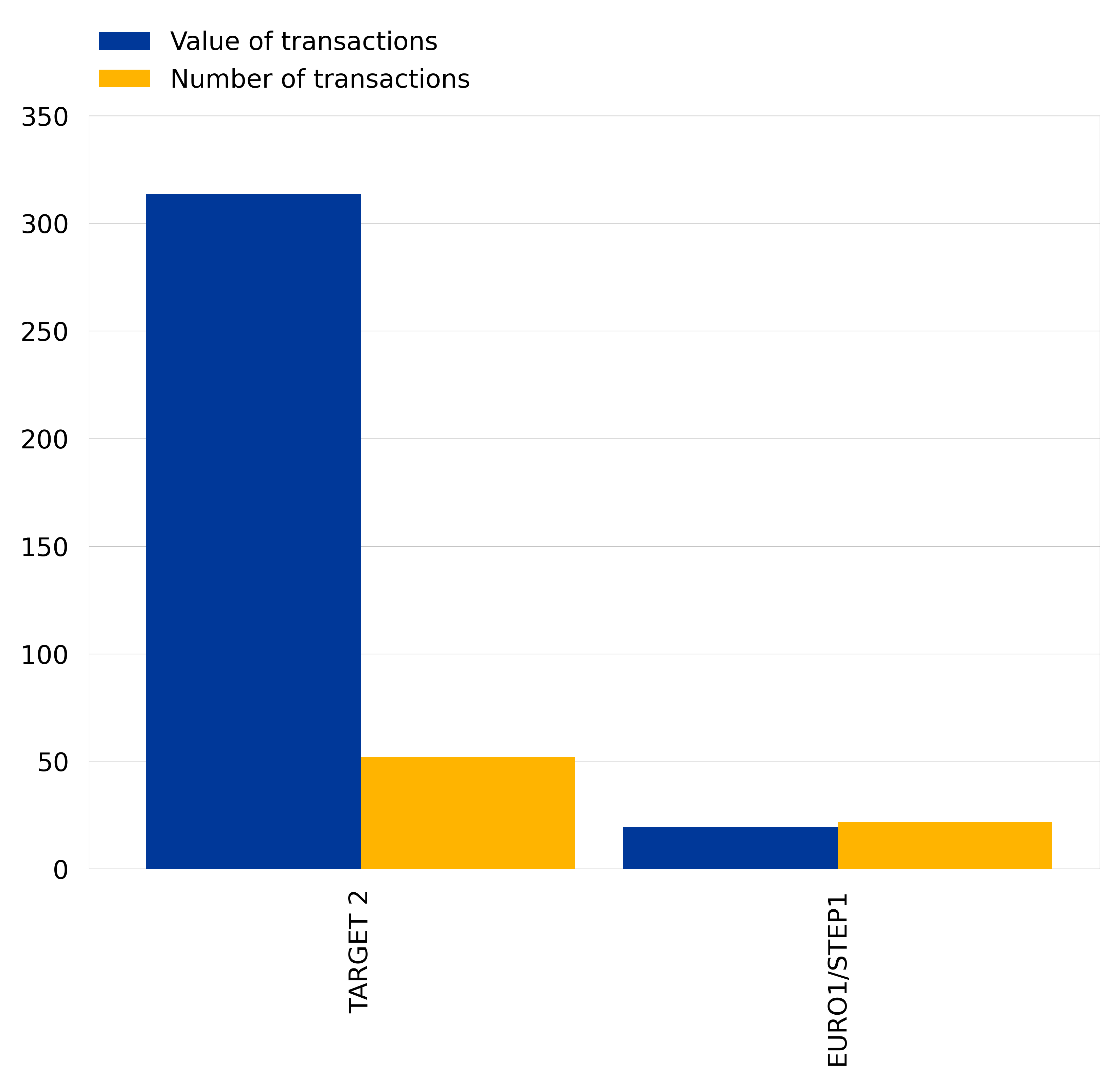
9 November 2023
The European Central Bank (ECB) today published the statistics on non-cash payments for the first and second halves of 2022.[2] The statistics comprise indicators on access to and use of payment services, payment cards and terminals by the public, as well as volumes and values of transactions processed through retail and large-value payment systems. This press release focuses on developments in the euro area as a whole, although statistics are also published for all euro area countries and all reporting non-euro area countries. EU and euro area aggregates are also published.[3]
Payment services[4]
In the second half of 2022 the total number of non-cash payment transactions[5] in the euro area increased by 8.8% to 65.9 billion compared with the previous six-month period, with the corresponding total value rising by 2.8% to €118.8 trillion. Card payments accounted for 54% of the total number of transactions, while credit transfers accounted for 20%, direct debits for 16% and e-money payments for 7%. The remaining 2% comprised cheques, money remittances and other payment services (see annex, Table 1).
Chart 1
Use of the main payment services in the euro area
(number of transactions in billions, right-hand-side scale refers to the first and second halves of 2022)
Source: ECB.
Note: Data have been partially estimated for periods prior to 2010, as methodological changes were implemented in previous years and some corresponding data are not available. The historical estimation done by the ECB ensures comparability of figures over the entire period. Statistics were also collected for cheques, money remittances and other payment services which together accounted for 2% of the total number of non-cash euro area payment transactions in the second half of 2022.
When considering annual figures for non-cash payment transactions in the reference year 2022, the total number of transactions increased by 10.9% to 126.6 billion compared with 2021, and their value increased by 17.5% to €234.3 trillion (see annex, Table 2).[6] The individual shares of card payments, credit transfers, direct debits, e-money payments and the remaining payment services (cheques, money remittances and other payment services) in the total number of non-cash payment transactions for 2022 were broadly in line with the ones observed for the second half of 2022.
Card payments
In the second half of 2022 the number of card-based payments within the euro area increased by 13.5% to 35.8 billion compared with the previous six-month period. The corresponding total value of card-based payments rose by 14.3% to €1.5 trillion, reflecting an average value of around €41 per transaction. The split between remote and non-remote transactions in the total number of card payments was 17% to 83%, while the split in terms of value was 25% to 75%. The number of contactless card payments initiated at a physical electronic funds transfer point of sale terminal increased by 17.7% to 19.3 billion compared with the previous six-month period, with the corresponding total value rising by 20% to €0.5 trillion. At the national level, Portugal had the largest share of card payments as a percentage of the total number of non-cash payments in the second half of 2022, at around 75% (see annex, Table 3).
Credit transfers
In the second half of 2022 the number of credit transfers within the euro area increased by 5.1% to 13.4 billion compared with the previous six-month period, and the corresponding total value rose by 2.2% to €111.0 trillion. As higher-value payments are usually made by credit transfer, credit transfers made up 93.5% of the total value of non-cash payments. The relative importance of the number of credit transfers initiated electronically continued to increase, with the ratio of transactions initiated electronically to paper based transactions at around 21 to 1, while in terms of value the ratio was around 12 to 1. At the national level, Latvia had the largest share of credit transfers as a percentage of the total number of non-cash payments in the second half of 2022, at around 37% (see annex, Table 3).
Direct debits
In the second half of 2022 the number of direct debits within the euro area increased by 0.8% to 10.7 billion compared with the previous six-month period, and the corresponding total value rose by 14.4% to €4.4 trillion. Of the total number of direct debits, those with an electronic mandate accounted for 13% whereas those with consent given in other forms accounted for 87%, while in terms of value the split was 18% to 82%. At the national level, Germany had the largest share of direct debits as a percentage of the total number of non-cash payments in the second half of 2022, at around 36% (see annex, Table 3).
E-money payments
In the second half of 2022 the number of e-money payment transactions within the euro area increased by 8.2% to 4.5 billion compared with the previous six-month period, and the corresponding value rose by 12.2% to €0.3 billion. Of the total number of e-money payment transactions, those made with cards on which e-money can be stored accounted for 22% whereas those made with e-money accounts accounted for 78%, while in terms of value the split was 18% to 82%.
Cards and accepting devices
In the second half of 2022 the number of cards with a payment function increased by 3.8% to 704.8 million compared with the previous six-month period. With a total euro area population of around 345 million, this averaged two payment cards per euro area inhabitant.
In the second half of 2022 the total number of automated teller machines (ATMs) in the euro area decreased by 2.8% to 262,066. Of these, 27% accepted contactless transactions.
The number of point of sale (POS) terminals increased in the second half of 2022 by 7.7% to 19.6 million[7] compared with the previous six-month period. Of these terminals, 81% accepted contactless transactions.
Payment systems[8]
Retail payment systems
Retail payment systems in the euro area handle mainly payments that are made by individuals and businesses, with a relatively low value and high volume overall.
In the second half of 2022, 29 retail payment systems within the euro area processed around 29.4 billion transactions with a combined value of €23.5 trillion. Instant credit transfers accounted for 12% of the total number and for 4% of the total value of credit transfer transactions.
A high degree of concentration can be observed in euro area retail payment systems. The three largest systems (STEP2-T[9], CORE in France and RPS in Germany) processed 64% of the volume and 72% of the value of all transactions processed by euro area retail payment systems in the second half of 2022.
Chart 2 shows the number and value of transactions processed by the main retail payment systems in the second half of 2022.
Chart 2
Retail payment systems in the euro area in the second half of 2022
(value of transactions in EUR trillions and number of transactions in billions)

Data on retail payment systems
Large-value payment systems
Large-value payment systems are designed primarily to process large-value and/or high-priority payments made between system participants for their own account or on behalf of their customers. Although, as a rule, no minimum value is set for payments made through such systems, the average size of payments is usually relatively large.
In the second half of 2022, large-value payment systems settled 74.2 million payments with a total value of €333 trillion in euro payments, with TARGET2 and EURO1/STEP1 being the two main systems.[10]
Chart 3 shows the number and value of transactions processed by the main large-value payment systems in the second half of 2022.
Chart 3
Main large-value payment systems in the euro area in the second half of 2022
(value of transactions in EUR trillions and number of transactions in billions)

Data on large-value payment systems
Notes:
- The full set of payment statistics can be downloaded from the ECB Data Portal (EDP). The EDP also includes interactive dashboards supporting data visualization. Detailed methodological information, including a list of all data definitions, is available under “Payment services and large-value and retail payment systems” in the “Statistics” section of the ECB’s website.
- The methodological and reporting framework for payments statistics has been enhanced to take progressive developments in the payments market and related changes in the legal framework in Europe into account. The reporting requirements are set out in Regulation ECB/2020/59 amending Regulation ECB/2013/43 on payments statistics and in Guideline ECB/2021/13 on reporting requirements on payments statistics. In addition, the Manual on payments statistics reporting is available on the ECB’s website.
- Hyperlinks in the main body of the press release and in annex tables lead to data that may change with subsequent releases as a result of revisions. Figures shown in annex tables are a snapshot of the data at the time of the current release. Unless otherwise indicated, statistics referring to the euro area cover the EU Member States that had adopted the euro at the time to which the data relate.






